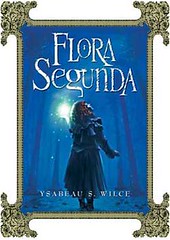In a comment to my entry introducing the word "Fillogy", Madama Hamerquist asked what's up with that? (I paraphrase, of course--her actual query was a put a bit more elegantly)--why are publishers mad for trilogies and series? Madama Hamerquist is not the only one asking me thus; I recently had lunch with several YA librarians who bemoaned the fact that so few stand-alone books, particularly in the fantasy genre, were being published, and that not all young readers were up to the challenge of a multi-part series. Some kids just wanted to read one book and be done with it. Why, why, why? they asked, as though somehow I, the lone author in the conversation, had some special insight into the byzantine world of publishing.
Well, I don't claim to have done exhaustive research into the matter, nor to have special insight, but I do have a few theories, which I shall raise up the flagpole. Feel free to salute.
My first theory is that, of course, writers like to have a sure thing, and a multi book deal is a sure thing. With a multi-book deal the writer knows where her next meal is coming from, and it's been my experience that most writers like to eat. So most writers are only too happy to come up with ideas that will take several books to play out. And of course when writers invests a lot of time and effort into world and character building, they like to be able to use them more than once.
Publishers like series because if they can also be a sure thing--get the reader hooked on book one and they'll come back for more. And more. And more. Some series are fillogies--the book started out long for one volume, but was rather too short to be easily split up into two, and didn't have enough bulk to go into three, so the editor and author padded out. Sometimes this padding works and sometimes it doesn't. I think, also, that some publishers are worried about super fat books--word cubes--there's certainly an audience for word cubes, but many readers are turned off by thick books, which can seem intimidating, so easier to chop the book up into bits. The most famous example of this would be Lord of the Rings.
But really, I think it all comes down to familiarity. Readers coming back for more. This sentiment seems to be prevailing in the movie industry as well. Most of the big hits these days are sequels, and some are even sequels to sequels.
This is not new, of course. There's the two/three volume novel was a staple of the 19th century; I'm thinking here of such tomes as Euegne Sue's The Mysteries of Paris, which was published in two volumes. Literature majors will no doubt be able to point to hundreds more examples of that, and sequels to sequels etc.
As for me, I had always planned on writing three books about Flora, but I never planned on having one plot play out through the three volumes. I wanted each book to have its own distinct plot with its own distinct resolution. Some larger plot points would carry over through the books to culminate in the third, but I didn't want to leave readers hanging at the end of each book. There's nothing wrong with cliff-hangers per say; I'm particularly fond of them as chapter endings (as I'm sure you all have noticed), but I find them frustrating at the end of a novel. Particularly when the next installment might be a year or so off. It seems woefully unfair to readers stuck with you for hundreds of pages only to be left high and dry, and told to come back later if they wish satisfaction.
So while each volume of Flora's adventures is self-contained, they do have commonalities, and issues which carry over--much like real life, things do not get tidily resolved--but I hope I have found some balance between giving the reader a satisfying conclusion and encouraging them to want more.
'Cause there's more coming, that I promise!
Tuesday, May 1, 2007
Subscribe to:
Post Comments (Atom)











1 comment:
I think you've nailed it on all points. Consider yourself saluted, Ms. Byzantine Tour Guide! My only remaining source of bewilderment is that it appears publishers are almost as leery of skinny books as they are of word cubes. I suppose there's a certain volume thickness which they've discovered makes the most economic sense for them to produce, and lures readers without scaring them off.
I have a couple more queries, if you happen to check back here:
1) What does "Cierra Califa" mean?
2) I gathered from one of your interviews that Flora Segunda was written in astoundingly short order. How long did it take you to write the story Metal More Attractive, which as you know I consider the best short fiction ever to grace my book-bloated eyes? (Ew ... better rethink that line.)
3) When are the book plates going to be available?
Post a Comment